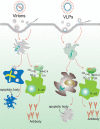The application of virus-like particles as vaccines and biological vehicles
- PMID: 26454868
- PMCID: PMC7080154
- DOI: 10.1007/s00253-015-7000-8
The application of virus-like particles as vaccines and biological vehicles
Abstract
Virus-like particles (VLPs) can be spontaneously self-assembled by viral structural proteins under appropriate conditions in vitro while excluding the genetic material and potential replication probability. In addition, VLPs possess several features including can be rapidly produced in large quantities through existing expression systems, highly resembling native viruses in terms of conformation and appearance, and displaying repeated cluster of epitopes. Their capsids can be modified via genetic insertion or chemical conjugation which facilitating the multivalent display of a homologous or heterogeneous epitope antigen. Therefore, VLPs are considered as a safe and effective candidate of prophylactic and therapeutic vaccines. VLPs, with a diameter of approximately 20 to 150 nm, also have the characteristics of nanometer materials, such as large surface area, surface-accessible amino acids with reactive moieties (e.g., lysine and glutamic acid residues), inerratic spatial structure, and good biocompatibility. Therefore, assembled VLPs have great potential as a delivery system for specifically carrying a variety of materials. This review summarized recent researches on VLP development as vaccines and biological vehicles, which demonstrated the advantages and potential of VLPs in disease control and prevention and diagnosis. Then, the prospect of VLP biology application in the future is discussed as well.
Keywords: Diagnostic technology; Drug delivery; VLPs; Vaccine; Virus-like particles.
Figures




References
-
- Agnello D, Herve CA, Lavaux A, Darniot M, Guillon P, Charpilienne A, Pothier P. Intrarectal immunization with rotavirus 2/6 virus-like particles induces an antirotavirus immune response localized in the intestinal mucosa and protects against rotavirus infection in mice. J Virol. 2006;80(8):3823–3832. doi: 10.1128/JVI.80.8.3823-3832.2006. - DOI - PMC - PubMed
Publication types
MeSH terms
Substances
LinkOut - more resources
Full Text Sources
Other Literature Sources

